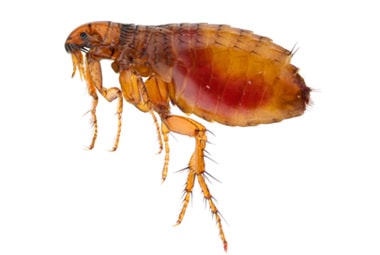
Cat fleas are a type of parasitic pest that feed on the blood of mammals. Besides causing itching and discomfort for their victim, they can transmit a variety of dangerous diseases. Cat fleas are found throughout the entire United States.
| Pest Identification | |
|---|---|
| Recognition | Adult fleas are very small in size. Only growing to be between 1/12th-1/6th of an inch in length. They are a reddish-dark brown in color, wingless, and have a flattened hard body. They have six legs that are long and very powerful. This allows them to have a very impressive 8 inch vertical jump. |
| Biology | Adult fleas can live for about 100 days. During their lifetime the females can produce 400-500 offspring. The life cycle of a flea begins after the female flea has a blood meal. Directly after feeding she has the nutrients she needs to produce her eggs. She lays the eggs on a host where they can then fall off onto the ground, flooring, furniture, or wherever they happen to land. Two days later the worm-like larva emerges from the egg. After about 5-15 days of feeding on organic debris or the adult’s fecal matter, they will enter into their pupal stage. The pupal stage can last days, weeks, months, or longer depending on environmental conditions. After the pupae develop into an adult as quickly as possible they find a host to jump onto where they begin feeding in about 24-28 hours. Flea reproduction takes place indoors year-round, but outdoor reproduction is limited to warm-weather months that meet the correct humidity and temperature requirements. Cat fleas can transmit a variety of dangerous diseases including the plague, and murine typhus. Cat fleas serve as intermediate hosts of the dog tapeworm and the rodent tapeworm which can infest humans, dogs, and cats. |
| Habits | Fleas transport themselves on rodents and other mammals where they usually remain at all times. Fleas are often brought inside of home on pets, like cats and dogs, that have spent time outdoors. However, this is not the only way that your home can become infested with fleas. Having an 8 inch vertical jump enables them to easily get onto your shoes and clothing and thus allowing you to bring them inside with you. Fleas can also get into homes on furniture, rugs or other items that are already infested are brought into your home. |
| Prevention | The best way to control fleas within your home is to make sure that all pets are treated with a flea preventative under the guidance of their veterinarian. Pets should be regularly inspected for fleas, and their bedding should be routinely washed. Making sure to regularly vacuum and wash floors and carpets, along with vacuuming furniture and washing all bedding can also help to keep flea infestations under control. Making changes around your property to deter wild animals like raccoons, mice, squirrels, and others can help to control the amount of fleas that are introduced to your property. |
| Professional | If fleas have invaded your home the quickest and most effective way to completely eliminate them from your home is to get help from a professional pest control expert. After your home is thoroughly vacuumed and cleaned a Rottler technician will apply an appropriately labeled residual insecticide and insect growth regulator (IGR) on carpeting, non-staining floors and upholstered furniture. This process requires pets and people to leave the home until it completely dries. If the technicians deem it necessary, they will perform spot treatment outside of your home in shaded areas around the foundation of your home, around trees, and under deck and porches. |

